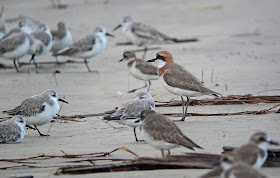
Dawn looking toward Mount Santubong.


As we drove I was asking Daniel about Cinnamon-headed Green Pigeons when he pointed up at the top of a roadside tree, stopped the car and said - "There - is that one?" Indeed it was - a pair in fact , and a lifer for me!

This is the female, with her distinctive narrow, red-based bill.
The only access to the beach with the roost was via a padlocked barrier across a track. A notice next to the barrier gave a phone number and said that an entrance fee of RM5 would be charged. I thoroughly approved of this piece of initiative! I'm all for local communities looking after their wild spaces, and profiting from them.

The roost itself was quite small - about 115 birds of just 6 species.

We approached the birds by driving along the beach. I took the 'back seat' - sitting in the open with some camo webbing over me.

The species present were all sandy-substrate preferring species, with Greater Sand Plovers being the commonest. Greaters tend to outnumber Lessers in sandy habitats, since their preferred prey is crabs, whereas Lessers feed on mud-loving marine worms.

There was one male in very fine fresh breeding plumage. Greater Sand Plover moult a month or two earlier than Lessers in spring, perhaps because their breeding grounds are further south and therefore become available earlier in the northern spring.


This bird had undergone a full moult of both body and wing and tail feathers and was in pristine condition.

There'll be many more of these stunning beauties in the next couple of months!

Sanderlings and Kentish Plovers made up the bulk of the rest of the flock. You can see the distinctive feet of the Sanderlings in this picture. Sanderlings are unique among the calidrid sandpipers in lacking a hind toe; a modification which helps them run at great speed.

Sanderlings look superficially like stints.


However, their feeding habits are quite different. They 'chase the waves' in flocks - speeding along the tideline to catch prey left by retreating waves and frequently burying their bills up to the hilt in the waterlogged sand.

Surf's up - gotta catch that wave!

Kentish Plovers in East Malaysia are very interesting! 90% of them have pale flesh-coloured legs. Males are rather dull on the crown and the breast patches are long, sometimes extending right across the breast to form an unbroken band. They look just like birds which occur in Japan (see here and here and not at all like the birds we get in Peninsular Malaysia. These are mostly dark-legged, have shorter breast patches and the males are much brighter-crowned (see this bird, photographed in Penang on 21 January 2007, for example). In my view, these East Malaysian birds correspond to what Deignan identified as the 'nihonensis' race, whereas the West Malaysian birds appear to be predominantly the nominate 'alexandrinus' race.

Another pink-legged male.

A male and female.

A female.

This bird had pale grey legs.


Note the complete breastband (and pink legs) of this bird.

One could be forgiven for confusing these pale-legged, breastbanded Kentish (left) with Malaysian Plover (right).


A male Malaysian Plover, with the typically stubby-billed, long-legged structure of the species.


The second bird had some male plumage characteristics (black breastband and frontal bar) but was behaving in a way that indicated it must be the female of the pair.


A few Terek Sandpipers made up the party.

I'm very happy to pay RM5 if it keeps the beach free of disturbance and litter!






Wow is that a microphone at the tripod?
ReplyDeleteHi Ronnie
ReplyDeleteHaha - no - just the tripod head handle!
Dave
Hi, just wanted to say how much I appreciate your careful explanations. My shorebird knowledge is atrocious, but some of your pictures and explanations are helping me to start to get an eye for these. Thanks for sharing not just your lovely photos but all your thinking and understanding of these birds
ReplyDeleteHi Gretchen,
ReplyDeleteThat's real encouragement for me! It's sometimes difficult for me to judge whether or not my efforts are helpful, so thanks for giving me a bit of feedback!
Dave
I'll second what Gretchen said about the information you put up is very helpful. I was looking through your blog about 3 weeks ago looking at your posts on the differences between Lesser and Greater Sand Plovers to help me ID one I saw recently. I found what you posted and the images of the 2 birds in the same image were invaluable in helping ID the bird I saw.
ReplyDeleteThanks to you too Mark!
ReplyDeleteDave
Hi Dave, I especially like the shots of the waders in flight in front of the surf !
ReplyDeleteAnd, although I've seen Greater Sand Plovers taking crabs here in HK, it had not occurred to me that I'd never noticed a Lesser SP doing the same.
(I have slapped myself on the wrist) :-)
John
Hi John
ReplyDeleteIt's a working hypothesis. Let me know if you do see LSPs taking crabs! Choice of prey influences hunting behaviour too - GSPs are runners (like KPs) while LSPs are walkers.
Dave